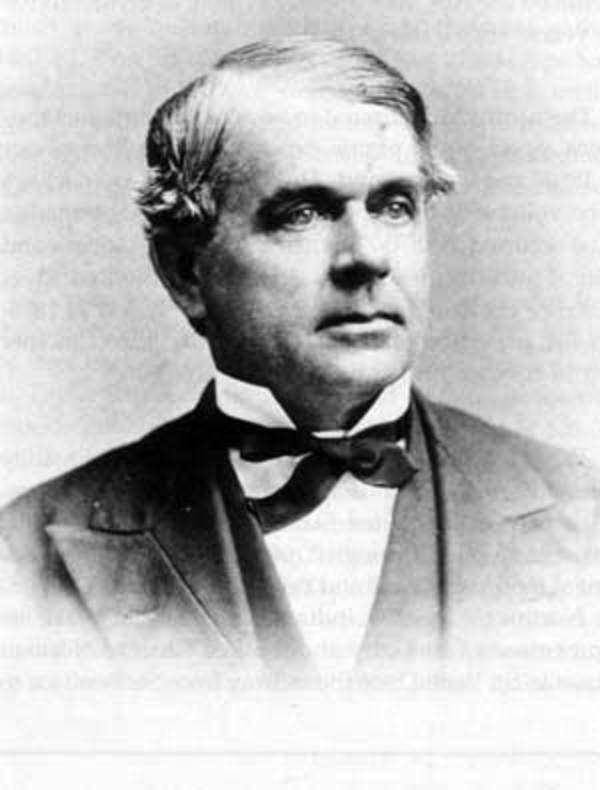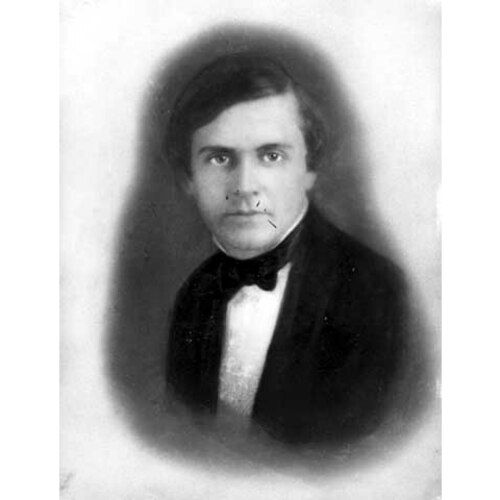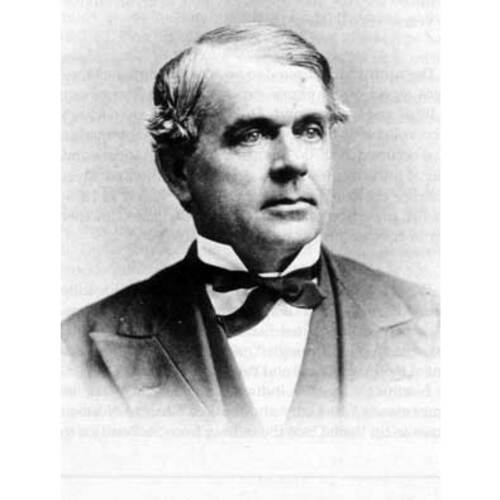
Source: Link
TAYLOR, JAMES WICKES, American consul and author; b. 6 Nov. 1819 in Starkey, N.Y., eldest son of James Taylor and Maria Wickes; m. 1845 Chloe Sweeting Langford, and they had five daughters; d. 28 April 1893 in Winnipeg.
After graduation in 1838 from Hamilton College, Clinton, N.Y., James Wickes Taylor returned home to Penn Yan, N.Y., to study law in his father’s office. Finding the society of Penn Yan narrow and uncongenial he moved in 1842 to Cincinnati, Ohio, where, after being admitted to the bar, he combined the practice of law in the office of Salmon Portland Chase with employment on the Cincinnati Enquirer. In 1846 he established the short-lived Cincinnati Morning Signal and became active in politics, supporting the Democratic party and opposing the extension of slavery. For a short period he edited a newspaper in Sandusky, and from 1852 until 1856 he was the state librarian, in Columbus.
As librarian, Taylor took an interest in the history and resources of the American and Canadian northwest. In 1854 he published History of the state of Ohio (Cincinnati). Two years later a series of lectures he gave before the General Assembly of Ohio was published as “Geographical memoir of a district of North America. . . .” In this work he referred to the inevitability of a railway line from Lake Superior to Puget Sound. The line would cross the extensive and unexplored “Saskatchewan plain,” an area of extraordinary fertility which “we are not at liberty to doom to sterility and solitude.” Such sentiment became the dominant theme of Taylor’s career in the United States and Canada. He worked to bring the northwestern territories of British North America into the American union and stated in 1865 that if the Canadas and Britain were not prepared to develop the area they should surrender it to the American people “who would not decline the opportunity to discharge the responsibility.”
By 1856 Taylor had become an accomplished writer and public speaker. He had gained experience while supporting Chase’s political career and promoting the abolition of slavery. But he was dissatisfied with his own political career. His hopes of becoming a senator had not been realized and he was financially embarrassed. He moved west to St Paul (Minn.), where he continued to combine his law practice with newspaper work and soon became caught up in the passion for expansion and railway building that characterized Minnesota Territory in the 1850s. During the previous decade, when American expansionist sentiment had focused on the annexation of Texas, Taylor had been opposed to its inclusion in the union, believing, as many did at the time, that it should be a separate republic. His commitment now to the American expansionist movement was a reversal of this earlier position.
Taylor became a promoter of the agricultural potential of the Hudson’s Bay Company territories. Through the St Paul Advertiser he familiarized the public with their resources and referred constantly to the relationship of that region to Minnesota. “Here is an object,” he wrote in 1857, “which removes our destiny from the insignificance of a frontier state, making our rivers and railroads the through fares to and from regions . . . destined to be an Empire in population and resources before the termination of the century.” That same year Lorin Blodget published Climatology of the United States, and of the temperate latitudes of the North American continent . . . (Philadelphia), which included statistics and observations on the climate and resources of the HBC territories. According to Blodget, the capacity of the region for agriculture and settlement had been “much underrated and greatly misunderstood.” Taylor and the Minnesota expansionists saw in Blodget’s book the scientific basis for their own contentions regarding the agricultural possibilities of the territories, as well as reinforcement for their efforts in arousing support for American annexation of the northwest.
In 1859, at the request of the governor of Minnesota, Henry Hastings Sibley, Taylor visited the Red River settlement (Man.). His report recommended the extension of the Reciprocity Treaty of 1854 to the British territories in the northwest. He believed that commercial advantages would accrue to the United States without the necessity of annexation. That year he was appointed a special agent of the Department of Treasury to investigate trade and transportation between the United States and the HBC territories. (He remained in the post until 1869.) At the time of his appointment, the Reciprocity Treaty was under attack by American timber, grain, transportation, and manufacturing interests. To counter the attack Senator Henry Mower Rice of Minnesota secured approval from the department for a study of the treaty by Taylor. In 1860 Taylor commented favourably on reciprocity and recommended its extension to the territories and British Columbia. In 1862 he provided a more detailed study in which he outlined the mutual value of the treaty and the potential market that existed to the northwest. He urged that no unnecessary restrictions be imposed on existing trade. The commercial ties already in place, added to the dissatisfaction of the inhabitants of the Red River settlement with the rule of the HBC, would lead to a popular movement for the colony’s entry into the United States. Although the Reciprocity Treaty was abrogated by the United States in 1866, the House of Representatives that year asked Taylor to examine the commercial relations between British North America and the United States. Taylor’s report, presented in June, associated the destiny of the British North American colonies with a transcontinental railway. He was confident that neither Britain nor the proposed confederation would construct such a line. At the same time he drew up a bill providing for the entry of the colonies and the HBC territories into the United States. The bill was submitted to the House of Representatives but died in committee.
Like all the Minnesota expansionists, Taylor believed that the instrument of annexation was the railway. He was convinced that, if the HBC territories could be made dependent for transportation and trade on St Paul, Canadians would be reluctant to build a transcontinental railway across the inhospitable country north of Lake Superior, and the territories would eventually fall into the political orbit of the United States. In 1857 he had become secretary of the Minnesota and Pacific Railroad Company, which was to build from St Paul north to the international boundary. Taylor was the railway’s most active publicist, always stressing its anticipated role in advancing Minnesota’s commercial destiny. The railway fell short of its initial expectations and in 1862 its charter was transferred to the newly organized St Paul and Pacific Railroad. Taylor became an energetic supporter of this new line.
Another railway expected to have an influence in promoting annexation was the Northern Pacific, which came under the control of financier Jay Cooke in 1869. The line was to extend from Duluth to Puget Sound, with a branch to the Red River settlement. Taylor worked as a lobbyist in Washington and as a press agent to promote the interests of the Northern Pacific, never failing to point out the political aspect of its development. In 1870 he revived the annexation bill of 1866 and stated that such a measure could be advanced only in association with the Northern Pacific. That same year he wrote to the American secretary of state underlining the important role that Minnesota railways could play in the promotion of annexation. If support were forthcoming from Congress, he argued, it would “exert a marked influence” on the deliberations of the provisional government of Louis Riel* at Upper Fort Garry (Winnipeg) and would “do more than all other agencies to determine the future relations of Northwest British America.” To Taylor’s frustration no Minnesota railway was sufficiently advanced by 1870 to influence events at Red River.
At the outbreak of the Riel rebellion in 1869, Taylor had sensed a unique opportunity to bring about annexation. That December he was appointed a secret agent of the Department of State to report on affairs at Red River. The department asked him to provide full details of the “revolt” and the “character and disposition of the population.” Taylor was in Ottawa in 1870 when the delegates from the provisional government, John Black*, Joseph-Noël Ritchot*, and Alfred Henry Scott*, were discussing the terms of the settlement’s entry into confederation. In a later report to the department he referred to the possibility of settlement beyond the new province of Manitoba and prophesied, “in that event, the story of the Winnipeg insurrection may be repeated sooner than the Ottawa cabinet anticipates.” He also kept the department (and Jay Cooke) informed of debates in the House of Commons on trade, tariffs, railways, and reciprocity.
Taylor’s appointment as American consul in Winnipeg in 1870, a post he held until his death in 1893, had been recommended by Senator Alexander Ramsey of Minnesota; Cooke urged him to accept the position. The Department of State considered Taylor to be “the best man we have got in all the Canadian provinces.” From his post in Winnipeg, Taylor persistently pleaded Riel’s case with the American government. He argued, as did the Métis, that the Canadian authorities had promised Riel an amnesty. When he suggested in 1874 that the United States ought to intervene in what he considered a breach of faith by Ottawa, he received a severe reprimand from the department, and was told that Washington “didn’t care a continental” about Riel. It was not his first reprimand. In September 1871, in response to rumours of a possible Fenian raid from the United States into Manitoba [see William Bernard O’Donoghue*] and fears that such a raid might be supported by the Métis, Taylor had sent word to the American military commander at Pembina (N.Dak.) who took action to prevent an “invasion.” For his efforts on behalf of the province, Lieutenant Governor Adams George Archibald expressed the government’s thanks. The Department of State, on the other hand, criticized him for what it called an “irregular” course in contacting army personnel directly rather than communicating through the department. At the time of the North-West rebellion in 1885, Taylor repeated his argument that the American government had a duty toward Riel, who had become an American citizen in 1883. In September 1885 he forwarded to the Department of State a petition from the Métis leader to President Stephen Grover Cleveland in which Riel, then in prison, asked for diplomatic intervention by the government of the United States to prevent his execution. No action was taken.
When Taylor had accepted the post of consul he had done so eagerly because he believed it was in Winnipeg that he could best pursue the goal of annexation. He fully expected further disturbances in the west. The French-speaking people of Manitoba felt betrayed by the Canadian government’s failure to provide an amnesty for Riel and those involved in the Red River rebellion. Many of these people, he was convinced, were anxious to join the United States. “I am forced to consider,” he reported from Winnipeg early in 1871, “the probability of anarchy and civil war.” At each crisis in Manitoba or the North-West Territories – dissatisfaction over Métis land grants, election riots, the disallowance of Manitoba railway legislation by the federal government [see John Norquay*], the rebellion of 1885 – Taylor’s hopes of annexation revived. He confidently expected that the Canadian confederation would not survive and that the American union would eventually extend over all of British North America, from the Atlantic to the Pacific.
Measured against his goals and ambitions Taylor might be considered a failure. He had espoused the causes of reciprocity, railway construction, and annexation. None of his plans or hopes were fulfilled, and after a certain time his views on these issues were no longer listened to in Washington. Although he succeeded in retaining his consular position through six American administrations (Democratic and Republican), he was denied a political career. He was never financially secure. His salary of $1,500 as consul was, he found, insufficient to support himself and educate his family. He sought, therefore, to supplement his income by writing, by requesting assistance from his friends, and by accepting other work. His correspondence is filled with suggestions for the appointment of Congressional committees of inquiry which might provide him some employment. His attempts at securing a permanent post with the Canadian Pacific Railway or the HBC were unsuccessful. At times he was despondent, impatient with what he termed his “exile” and “foreign residence” which separated him from his wife and family. Because of his financial situation he was never able to establish a home in Winnipeg, his wife and family living in St Paul while he attended to his consular duties. As consul he maintained an association with companies accepting his claim that he could advance their interests by promoting and publicizing the resources and potential of western Canada. These firms included the St Paul and Pacific Railroad Company, the Northern Pacific Railroad Company, the Minnesota Stage Company, the Red River Transportation Company, and the CPR. Each year he pleaded for a continuance of the subsidies they had been providing to him. When the CPR discontinued its allowance in 1889, he requested that his daughter Elizabeth, a travel writer and illustrator, be placed on the company’s payroll, arguing that her work was of value in furthering the immigration policy of the railway.
So conscientious had Taylor been in his promotional work that in 1891 the American railway magnate James Jerome Hill* claimed that he had done a disservice to the United States. Taylor denied the charge. He continued to think of the Canadian west as a potential economic hinterland of the United States and argued that his efforts were “intended and have resulted in securing to my country the lion’s share of advantage and progress.” For example, in 1871 he had obtained from the American Department of Treasury bonding regulations that facilitated the movement of immigrants through the United States to Manitoba. For this he was much praised in Manitoba – but, by promoting the development of the Canadian west he was, he argued, advancing traffic for Minnesota railways; many immigrants travelling through the United States would stay there and take up lands along the lines of the Northern Pacific as well as the St Paul and Pacific.
In spite of the frustrations and “exile,” Taylor, according to his contemporaries in Winnipeg, was a gentle, charming, genial, and courteous gentleman, a popular and well-known figure in the city. His efforts in promoting the Canadian west were appreciated, few apparently realizing that for years he had hoped to see the west annexed to the United States. At the time of his death a Winnipeg newspaper wrote: “So closely . . . had Consul Taylor been identified with the history and development of our country, and so earnest a friend did he prove himself of it, that he attracted to himself an amount of respect and genuine love on the part of the public which few men ever accumulate even in their own land.” In 1893, the year of his death, a full-length portrait by Victor Albert Long was placed in the chambers of the Winnipeg City Council. Taylor was buried in Utica, N.Y., beside his wife who had died the previous year.
A journal kept by James Wickes Taylor has been published as “A choice nook of memory,” the diary of a Cincinnati law clerk, 1842–1844, ed. J. T. Dunn (Columbus, Ohio, 1950), and part of his correspondence as The James Wickes Taylor correspondence, 1859–1870, intro. and ed. Hartwell Bowsfield (Winnipeg, 1968). The introduction to the second work refers to a number of Taylor’s writings and contains a fuller list of the sources used in the preparation of this biography. Some of Taylor’s writings are also listed in T. C. Blegen, “James Wickes Taylor: a biographical sketch,” Minn. Hist. Bull. (St Paul), 1 (1915): 158–219.
National Arch. (Washington), RG 84, records of State Dept. special agents, Red River settlement, Manitoba, 1869–70, and records of the U.S. consul, Winnipeg, 1870–93; RG 206, general corr., letters from Treasury Dept. special agents, 1859–69. Minn. Hist. Soc. (St Paul), J. W. Taylor papers. H. C. Knox, “Consul Taylor of Red River,” Beaver, outfit 279 (March 1949): 16–18; outfit 280 (June 1949): 34–37.
Cite This Article
Hartwell Bowsfield, “TAYLOR, JAMES WICKES,” in Dictionary of Canadian Biography, vol. 12, University of Toronto/Université Laval, 2003–, accessed January 9, 2026, https://www.biographi.ca/en/bio/taylor_james_wickes_12E.html.
The citation above shows the format for footnotes and endnotes according to the Chicago manual of style (16th edition). Information to be used in other citation formats:
| Permalink: | https://www.biographi.ca/en/bio/taylor_james_wickes_12E.html |
| Author of Article: | Hartwell Bowsfield |
| Title of Article: | TAYLOR, JAMES WICKES |
| Publication Name: | Dictionary of Canadian Biography, vol. 12 |
| Publisher: | University of Toronto/Université Laval |
| Year of publication: | 1990 |
| Year of revision: | 1990 |
| Access Date: | January 9, 2026 |




